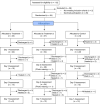Effectiveness of skin cleanser and protectant regimen on incontinence-associated dermatitis outcomes in acute care patients: A cluster randomised trial
- PMID: 33960676
- PMCID: PMC8613386
- DOI: 10.1111/iwj.13588
Effectiveness of skin cleanser and protectant regimen on incontinence-associated dermatitis outcomes in acute care patients: A cluster randomised trial
Erratum in
-
Corrigendum.Int Wound J. 2022 Nov;19(7):1955. doi: 10.1111/iwj.13826. Int Wound J. 2022. PMID: 36305527 Free PMC article. No abstract available.
Abstract
Skin cleansers and protectants protect skin from incontinent matter to reduce the risk of incontinence-associated dermatitis (IAD), but their effectiveness treating established IAD in the tropics is unknown. We conducted an open-label cluster randomised trial to compare the effectiveness of a combined regimen of (1) specialised skin cleansers with disposable body wipes and (2) either an acrylic terpolymer (T1) or zinc oxide (T2) skin protectant against disposable body wipes and zinc oxide protectant (control) in promoting IAD healing and reducing the risk of deterioration. Eighty-four patients were recruited in a tertiary hospital in Singapore between April 2019 and January 2020 (T1: n = 23; T2: n = 37; Control: n = 24). Although not statistically significant, patients treated with T1 and T2 were 1.5 times as likely to experience IAD healing within seven days compared with the control (P = .66). Healing was more pronounced in participants with skin loss treated with T1 or T2. No treatment was superior in preventing IAD deterioration, the prevalence of which remained small (8%-14%). While skin cleaning and protectants reduced the overall risk of skin deterioration, the addition of skin cleansers enhanced IAD healing within a short period, an important consideration for future research examining IAD treatment in acute care.
Keywords: dermatitis; dermatologic agents; incontinence-associated dermatitis; irritant; wound healing.
© 2021 The Authors. International Wound Journal published by Medicalhelplines.com Inc (3M) and John Wiley & Sons Ltd.
Conflict of interest statement
The authors declared no potential conflicts of interest.
Figures
References
-
- Beele H, Smet S, Van Damme N, Beeckman D. Incontinence‐associated dermatitis: pathogenesis, contributing factors, prevention and management options. Drugs Aging. 2018;35(1):1‐10. - PubMed
-
- Pather P, Hines S. Best practice nursing care for ICU patients with incontinence‐associated dermatitis and skin complications resulting from faecal incontinence and diarrhoea. Int J Evid Based Healthc. 2016;14(1):15‐23. - PubMed
-
- Junkin J, Selekof JL. Prevalence of incontinence and associated skin injury in the acute care inpatient. J Wound Ostomy Continence Nurs. 2007;34(3):260‐269. - PubMed
-
- Van Damme N, Van den Bussche K, De Meyer D, Van Hecke A, Verhaeghe S, Beeckman D. Independent risk factors for the development of skin erosion due to incontinence (incontinence‐associated dermatitis category 2) in nursing home residents: results from a multivariate binary regression analysis. Int Wound J. 2017;14(5):801‐810. - PMC - PubMed
-
- Voegeli D. Prevention and management of incontinence‐associated dermatitis. Br J Nurs. 2017;26(20):1128‐1132. - PubMed
Publication types
MeSH terms
Substances
LinkOut - more resources
Full Text Sources
Other Literature Sources
Medical
Miscellaneous




